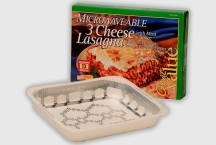Canadians add to allergen labeling requirements
Bread label clarifies whole-grain content
Study: Organics use on decline
Tray speeds lasagna heating
M&M’s go upscale

By Lisa McTigue Pierce
Editor-in-Chief
When CNN’s Lou Dobbs rails against an issue, he gets a lot of attention. But awareness alone isn’t enough to solve our problems. We need action. So when I heard newsman Dobbs criticize the food industry because of its so-called mishandling of the recent contamination episode with jalapeño peppers, I had to speak up. Especially when he and other analysts condemned food processors for fighting against country-of-origin labeling, which, in the analysts’ opinions, will help make our food supply safer.
First, country-of-origin labeling is not the same as track-and-trace. Not by a long shot. COOL simply identifies the origin of a product. Track-and-trace provides a record of a product (and its components) as it moves through the supply chain. The costs of implementing COOL are paltry compared to an integrated track-and-trace program. Just ask any pharmaceutical company that’s struggling to comply with electronic pedigree laws (their version of COOL).
Second, COOL would only provide a small advantage in speeding up a recall by narrowing the initial search down to one or two haystacks instead of, say, 10. But it wouldn’t help a bit in pinpointing the source of a contamination unless you buy from only one company in that country.
Third, COOL gives consumers almost useless information from a food safety point of view. Despite the fact that consumers, according to a report byDeloitte, overwhelmingly want country-of-origin labeling for fresh fish (84%), fresh fruits and vegetables (80%) and packaged food ingredients (69%), they would not use the information correctly in a time of crisis. If contaminated product originated from one farm in Country X, you know consumers would stop buying any product from any company from Country X well beyond the timeframe of any potential risk.
That all being said…We still need more action than me just spouting off. Face it: The food industry needs better track-and-trace capability than is currently required by the Bioterrorism Act or COOL regulation. Yes, it’s going to cost and, yes, it’s going to be hard to pass those costs on. But, it is going to save lives and, ultimately, will help you sell more product by improving consumers’ trust in their food supply.
Plenty of electronic or automated solutions exist, such as bar coding, taggants (primary used for anti-counterfeiting) and even radio frequency identification (RFID), which may see renewed interest.
There’s been some talk, though, that the government might mandate the type of technology to use. OMG! Hurry, band together and make it clear that, while it’s OK for the government to dictate what needs to be done, industry should control thehowto do it. It’s the only way you can manage the cost of implementation.
TOP DEVELOPMENTS
Canadians add to allergen labeling requirementsIn another step to strengthen food safety standards, the Canadian government is requiring that food allergens, added sulfites and gluten sources must be declared on all packaged food labels. The regulations are meant to reduce food recalls and allergic reactions. Several allergy studies have also been launched, including a national study of food allergy prevalence, and two studies on dietary habits and coping skills of people with celiac disease who keep a gluten-free diet.
Bread label clarifies whole-grain content
Sara Lee is changing the labels on its Soft & Smooth white bread to clarify the product’s whole grain amount. The Center for Science in Public Interest claimed that the product, made from mostly white flour, was misleading in claiming “whole grain goodness” on the label. The new labels will reflect the bread’s makeup of 30% whole grain.
Study: Organics use on decline
Organics may be reaching a plateau, according to a study from The Hartman Group. Consumer use of organics as a whole dropped from 73% to 69% between 2006 and 2008. Possible factors include the term “organic” having taken on so many meanings that its impact has been blunted, and increasing consumer interest in formerly fringe food categories such as fair-trade, artisan and free-range. Consumers are still responding strongly, however, to fresh organics, including dairy, fruit, vegetables and breads. Core organic consumers are still buying organics, while mid-level and peripheral consumers are focusing only on organic categories they really care about.

NEW PACKAGES
Tray speeds lasagna heatingA tray for Wal-Mart house brand frozen lasagna that cut microwave cooking time in half has won an award from theInstitute of Packaging Professionals. Wal-Mart switched its Great Value Lasagna to a MicroRite tray fromGraphic Packaging Int'l, which features aluminum and polyester laminated to a paperboard base. The aluminum concentrates and distributes the microwave energy, for faster, easier heating. Cook time in the microwave decreased from 28 minutes with the former packaging to 13 minutes with MicroRite.

A new, extra-fancy version of M&M’s comes in an extra-fancy package. M&M’s Premiums are deluxe versions of Mars Inc.’s iconic candy, in larger-than-normal nuggets with exotic flavors like mocha, raspberry almond and triple chocolate. The packaging is a tapered paperboard carton with a concave waist and a die-cut oval front-panel window that shows off the candy’s marbled texture. The carton’s colors are matched to the product’s color and flavor.
